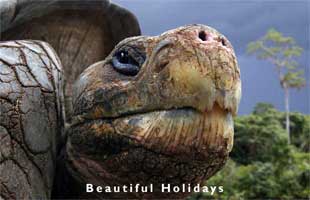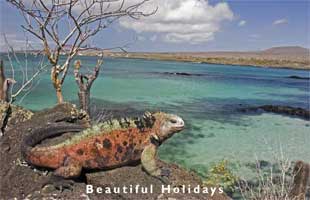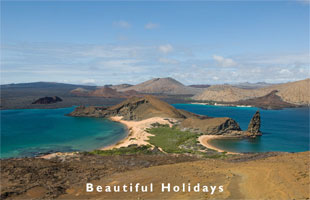Galapagos Islands Holidays & Accommodation
Ecuador, South America

Nature lovers dream about visiting the Galapagos to see the unique wildlife of the islands. Here there are marine iguanas that swim in the ocean, finch species that vary island to island, and giant tortoises that slumber without a care in the world. The unusual fauna of the islands extends to the marine environment, and the 133 000 square kilometres of the Galapagos Marine Reserve is home to some great underwater viewing opportunities for whale shark, Galapagos shark, and manta rays.

Map of Galapagos Islands

Galapagos Islands – Giant Tortoise
Galapagos Islands Holidays Planner
The Galapagos are an island archipelago 1000 km off the South American coast that were claimed by the newly sovereign country of Ecuador only two years before Darwin's arrival in the early 19th century. Although the archipelago is a sheltered and protected area, tourists are nevertheless allowed some access to the islands and waters of these islands. There is a population of 28 000, and further immigration is forbidden. There are 18 major islands, and people live on three major settlements on the islands. Puerto Ayora on Santa Cruz Island is the largest town, while there are smaller towns on San Cristobal and Isla Isabela. Here you can arrange for amenities like hotel stays.
The Galapagos Islands has animals, reptiles, and birdlife that display unique adaptations to their island life. They have never been hunted or tormented within their lifespan and display little or no fear of humans Snorkelling with tame sea lions, is one of the popular activities. The island has strict protection policies so almost all excursions are organised with knowledgable tour guides to minimize the impact visitors have on this fragile ecosystem. It's definitely not a place to head off and do your own thing.
Visitors will find a trip to these islands is not cheap, owing to the remote location, and the only way to get there is by plane from the Guayaquil or Quito airports. Once there, you can cruise the islands, hike, horseback ride, or dive off the coast of the islands. There are a limited number of tour companies in operation on the islands, but you can coordinate with them before your arrival from the mainland out of Guayaquil or Quito. It is a wonderful chance to explore a one-of-a-kind region, and many would consider it worth the expense.
On Bartholomew Island, you can see the world's only equatorial penguin, the Galapagos penguin. The ecosystem of the Galapagos are very unusual, and while on one island, you may find a species like the Waved Albatross thriving (Espanola Island), the efforts of the species to breed on neighbouring islands of the Galapagos are unsuccessful. Espanola is also known for its brightly coloured marine iquanas, and lava lizards. On Genovesa Island you can see the swallow-tail gull, the only nocturnal gull in the world, and on Wolf Island you may catch a glimpse of the elusive Vampire Finch whose diet is partially comprised of the blood it pecks from other birds.
People wanting to visit the Galapagos must do so with a certified guide. Visitors can arrange tours through tour operators either in their own country or in Ecuador at Quito or Guayaquil on Ecuador's mainland. Generally, the best way to get there is to fly to Baltra Island from the mainland. You can arrange with tour operators ahead of time for boat tours of the island. There are some things you want to keep in mind when booking with an operator, including the size of the party, what islands will be visited and for how long, and whether or not supplementary equipment like snorkelling/scuba gear and/or kayaks will be provided to guests. Generally, when you book a boating tour, the trip is for four days or more and you spend your time living on the boat.
It was in 1831 that Charles Darwin was commissioned as a naturalist aboard the Beagle by the British government. It was during these five years as part of this expedition, particularly during his visit to the unique ecosystem of the Galapagos Islands, that Darwin formed the basis of discoveries that informed his theory of natural selection and evolution.

